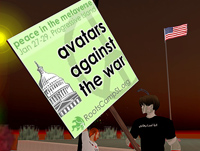From Andrew Sullivan, The Daily Dish:
Congress Freaks Out Over Second Life Terrorism
by Sharon Weinberger
Wired.com
April 4, 2008
 Oh no, the virtual terrorists are coming to get us! Well, maybe. Congress, in its infinite wisdom, had an entire hearing about virtual worlds and terrorism, even calling in the chief executive of Linden Lab to testify about the possibility of Second Life being used for evil terrorist ends. One of the concerns, brought up by some members of Congress, was that Second Life could be used launder terrorist funds. The possibility was quickly dispelled:
Oh no, the virtual terrorists are coming to get us! Well, maybe. Congress, in its infinite wisdom, had an entire hearing about virtual worlds and terrorism, even calling in the chief executive of Linden Lab to testify about the possibility of Second Life being used for evil terrorist ends. One of the concerns, brought up by some members of Congress, was that Second Life could be used launder terrorist funds. The possibility was quickly dispelled:
The average withdrawal from Second Life — from Linden dollars into U.S. dollars — is one dollar, so it’s “relatively easy to spot larger transactions,” [Philip] Rosedale said. “We have managed to maintain a fraud rate that is a fraction of a percentage point. The industry average is closer to 1 percent.”
Virtual community Entropia Universe last year earned $400,000 after it auctioned off banking licenses to several well-known virtual world players. The licenses allow their owners to lend cash to the community’s participants for the virtual purchase of anything from game-fighting weapons to real estate.
Second Life celeb Anshe Chung was among those who purchased a license.
Lawmakers on Tuesday denied that they were looking to regulate the virtual world.
Virtual reality is “going to be a highly competitive world. We just want to make sure it’s not highly regulated,” said ranking member Cliff Stearns of Florida.
There seems to be a trend here: THREAT LEVEL had described the Intel Community’s fascination with fighting terrorism in multi-player games. DANGER ROOM has written about spooks’ desire to recruit in Second Life. And, as we all know, industry has sunk a lot of money into creating a presence in Second Life. So perhaps it’s no surprise that Congress is worried about terrorists.
The problem is that Congress clearly doesn’t know quite what it’s worrying about; its sounds like some members are getting freaked out by something they don’t understand. As this Wired Magazine makes clear, a lot of the hoopla is just that:
Then there’s the question of what people do when they get there. Once you put in several hours flailing around learning how to function in Second Life, there isn’t much to do. That may explain why more than 85 percent of the avatars created have been abandoned. Linden’s in-world traffic tally, which factors in both the number of visitors and time spent, shows that the big draws for those who do return are free money and kinky sex. On a random day in June, the most popular location was Money Island (where Linden dollars, the official currency, are given away gratis), with a score of 136,000. Sexy Beach, one of several regions that offer virtual sex shops, dancing, and no-strings hookups, came in at 133,000. The Sears store on IBM’s Innovation Island had a traffic score of 281; Coke’s Virtual Thirst pavilion, a mere 27. And even when corporate destinations actually draw people, the PR can be less than ideal. Last winter, CNET’s in-world correspondent was conducting a live interview with Anshe Chung, an avatar said to have earned more than $1 million on virtual real estate deals, when Chung was assaulted by flying penises in a griefer attack.
Maybe Congress can legislate against flying penises.
